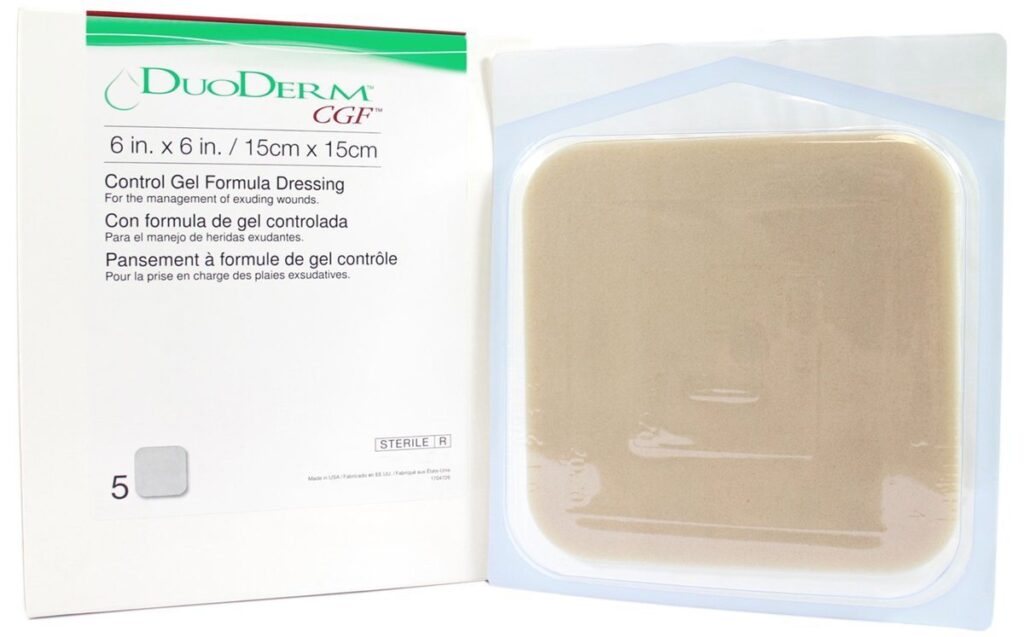Understanding Duoderm Dressing: Benefits and Usage

What is Duoderm Dressing?
Duoderm dressing is a specialized wound care product designed to promote healing while providing an optimal environment for various types of wounds. It is composed of a hydrocolloid material that combines various polymers and gel-forming agents. This composition allows the dressing to absorb exudate from wounds while maintaining moisture, which is crucial for an effective healing process. The hydrocolloid nature of Duoderm dressing contributes to its ability to create a moist wound healing environment that reduces pain, accelerates tissue regeneration, and minimizes the potential for infection.
There are several types of Duoderm dressings available, including both thin and thick options. The thinner types are often used for superficial wounds, while the thicker varieties are designed for deeper wounds or areas with significant exudate. Regardless of the type, all Duoderm dressings share common characteristics that make them distinct in the realm of wound care. A key feature is their adhesive border, which ensures that the dressing stays in place while providing a waterproof barrier against external contaminants.
What sets Duoderm dressing apart from other wound dressings is its unique ability to absorb and retain moisture without saturating the wound. Unlike traditional gauze, which can dry out the wound and promote scabbing, Duoderm maintains an optimum moisture level that supports cellular regeneration. This is particularly beneficial for patients with chronic wounds, pressure ulcers, or surgical incisions, where proper moisture balance is essential to expedite healing.
Furthermore, Duoderm dressings are transparent, allowing healthcare professionals to evaluate the wound condition without the need for frequent changes. This not only reduces discomfort for the patient but also promotes a better assessment of the wound progress. Overall, Duoderm dressing represents a significant advancement in wound management, offering a versatile and effective solution for various clinical scenarios.
Benefits of Using Duoderm Dressing
Duoderm dressing offers a multitude of benefits that significantly enhance wound management. One of the primary advantages of this hydrocolloid dressing is its superior moisture retention capabilities. By creating a moist environment at the wound site, Duoderm promotes optimal conditions for healing. This moist environment not only aids in tissue regeneration but also helps in reducing the risk of tissue desiccation, which can delay the recovery process.
Another notable benefit is the pain reduction experienced by patients using Duoderm dressing. The dressing acts as a barrier against external irritants, including friction and pressure, often leading to diminished pain during movement. Patients often report increased comfort levels, making a significant difference in their overall recovery experience. Furthermore, the dressing’s cushioning properties protect the wound from external contaminants, which is crucial for effective healing.
The ease of application associated with Duoderm dressing is another significant benefit. Its flexible nature allows it to conform to various body contours, which simplifies the application process and promotes patient compliance. Users appreciate that it can be gently removed without causing additional trauma to the healing tissue, thus ensuring that the surrounding skin remains intact and healthy.
Additionally, Duoderm dressing has been shown to promote faster healing in comparison to traditional dressings. Its ability to absorb exudate and maintain an optimal moisture level not only accelerates the healing process but also reduces the likelihood of infection. The use of Duoderm also minimizes the potential for scarring, as it supports natural skin healing mechanisms. Overall, the benefits of using Duoderm dressing are clear, making it an excellent choice for effective wound management.
Indications for Use of Duoderm Dressing
Duoderm dressing is specifically designed to address a variety of wound types, making it a versatile choice for both clinical and home care settings. One of the primary indications for its use includes diabetic ulcers. These wounds often result from prolonged pressure due to neuropathy and impaired blood circulation, leading to the potential for serious infections. Duoderm provides a moist environment that promotes healing while also protecting the wound from external contaminants.
Another significant application of Duoderm dressing is for pressure sores, also known as pressure ulcers. These sores typically develop in individuals with limited mobility who experience constant pressure on certain areas of the body. The dressing’s hydrocolloid properties allow it to absorb exudate while maintaining a moist interface, which is essential for tissue granulation and minimizing pain during dressing changes.
Furthermore, Duoderm is highly effective for post-surgical wounds. After surgical procedures, ensuring a moist wound healing environment is crucial for optimal recovery. The dressing helps in managing exudate and reduces the risk of infection, making it a preferred choice in postoperative care. Its transparent nature also allows for easy monitoring of the wound without the need for frequent changes, which can disrupt the healing process.
In addition to these applications, Duoderm dressing is also suitable for superficial burns and abrasions. The dressing aids in pain relief and accelerates healing while providing a barrier against friction. Therefore, understanding the specific types of wounds for which Duoderm dressing is recommended can significantly influence the effectiveness of wound management strategies. Ultimately, its multifaceted use should be weighed against other dressing options to determine the most appropriate choice for individual care needs.
How to Apply Duoderm Dressing Effectively
Applying Duoderm dressing correctly is crucial for promoting healing and preventing infection. The following step-by-step guide outlines the process to achieve optimal results.
First, ensure that you have all necessary supplies at hand, including the Duoderm dressing, sterile gloves, wound cleanser, scissors, and tape if required. Begin by thoroughly washing your hands to minimize the risk of introducing any bacterium to the wound site.
Next, assess the wound. If it appears dirty, it’s essential to cleanse it before applying the Duoderm dressing. Use a gentle, non-irritating wound cleanser and sterile gauze to clean the area. Make sure to remove any dead tissue or debris, as this can impede the effectiveness of the dressing and delay healing.
Once the wound is clean, dry the surrounding skin gently with a soft cloth or gauze. It is imperative that the skin is dry, as moisture can affect adhesion. Then, determine the appropriate size of the Duoderm dressing. Ideally, the dressing should extend at least one centimeter beyond the wound edges to ensure complete coverage.

Carefully remove the backing of the Duoderm dressing, taking care not to touch the adhesive side. Center the dressing over the wound and apply it gently, allowing the adhesive to stick to the skin. Smooth the edges with your fingers to ensure proper adhesion and eliminate any wrinkles that could compromise the dressing’s integrity.
Finally, secure the dressing with additional tape if necessary to enhance stability, preventing any potential displacement due to movement or moisture. Regularly monitor the dressing and the wound’s condition, changing the Duoderm dressing as directed or when it becomes saturated or loosened. Always avoid common mistakes such as applying the dressing to overly moist wounds or failing to wash hands before the procedure. By following these guidelines, you can maximize the efficacy of the Duoderm dressing in wound care.
How to Care for Wounds with Duoderm Dressing
Caring for wounds effectively is crucial to promoting healing and preventing complications. Using Duoderm dressing provides a moist environment that aids in the healing process, but proper care is essential to maximize its benefits. One of the primary considerations is how often to change the dressing. It is generally recommended to change Duoderm dressing every 3 to 7 days, depending on the level of exudate and the condition of the wound. If the dressing becomes saturated or starts to peel, it should be changed sooner to maintain an effective barrier against potential pathogens.
Monitoring for signs of infection is another critical aspect of wound care. Patients and caregivers should be vigilant for symptoms such as increased redness, swelling, warmth, or unusual discharge. If any of these signs are observed, it is imperative to consult a healthcare professional for further evaluation. Additionally, maintaining the hygiene of the dressing area is essential. This can include gently cleansing the surrounding skin with mild soap and water before applying a new dressing, ensuring that no irritants or contaminants are introduced into the wound area.
It is also important to schedule follow-up checks with a healthcare provider to assess the wound’s healing progress. Regular evaluations can help determine whether the current dressings are effective or if adjustments need to be made. Such assessments are crucial for identifying any complications early, thereby ensuring the ongoing health of the wound. Ultimately, when using Duoderm dressing, following these best practices can significantly enhance the healing process while minimizing the risk of infection. Ensuring proper care during this period can make a meaningful difference in the overall recovery experience.
Potential Side Effects and Precautions
While Duoderm dressing is widely regarded for its effectiveness in wound care, it is essential to be aware of potential side effects and precautions when utilizing this product. Although most individuals tolerate Duoderm dressing well, some may experience allergic reactions or skin irritation. Symptoms of an allergic reaction can include redness, swelling, itching, or a rash at the application site. In such cases, it is crucial to discontinue use immediately and consult a healthcare professional for further evaluation.
Additionally, individuals with a known sensitivity to any component of the dressing should avoid its application. Skin irritation may also occur due to prolonged contact with the dressing, especially in patients with fragile skin or those who have existing dermatological conditions. Healthcare providers often recommend monitoring the skin under the dressing to ensure that no adverse reactions arise during the treatment.
Before using Duoderm dressing, especially in circumstances involving open wounds, it is advisable to consult with a healthcare professional. They can assess whether this dressing is suitable for a specific situation, considering factors such as the type of wound, location, and patient history. Furthermore, responsible practitioners will emphasize hygiene guidelines, such as ensuring that the surrounding skin is clean and dry before application. This practice minimizes the risk of infection and optimizes the effectiveness of the dressing.
In summary, while Duoderm dressing can offer significant benefits in the management of wounds, awareness of potential side effects and precautions is vital. By remaining vigilant and consulting healthcare professionals as necessary, individuals can mitigate risks and enhance the overall healing process.
Comparing Duoderm Dressing with Other Wound Dressings
When it comes to effective wound management, selecting the appropriate dressing is crucial. Among the numerous options available, Duoderm dressing stands out due to its unique composition and characteristics. This dressing primarily focuses on providing a moist environment, which is essential in promoting faster healing. However, it is beneficial to consider how Duoderm dressing compares to other common types of wound dressings, such as transparent films, contact layers, and foams.
Transparent film dressings are designed to allow for the visualization of the wound while providing a barrier against water and bacteria. They are thin and flexible, making them suitable for minor wounds and superficial abrasions. However, they may not provide adequate moisture retention, which can be critical for healing. In contrast, Duoderm dressing offers a more occlusive environment, thus enhancing fluid absorption and maintaining an optimal humidity level, which is especially beneficial for moderate to heavily exuding wounds.
Contact layer dressings differ from Duoderm dressing in that they are typically used to protect fragile granulation tissue or to facilitate the removal of dressing materials without damaging the wound. While contact layers prevent adherence to the wound, they may require an additional secondary dressing to secure them in place. Duoderm dressing, on the other hand, can often be used as a primary dressing alone, simplifying application processes and reducing the risk of secondary infection.
Foam dressings are known for their absorbency and cushioning properties, making them an ideal choice for exuding wounds. However, while foam dressings can handle significant levels of exudate, they do not have the same ability to support a moist healing environment as Duoderm dressing. Ultimately, the choice between these dressings largely depends on the wound type and its specific condition. Understanding these distinctions can help clinicians and caregivers make informed decisions regarding the most suitable dressing to optimize patient outcomes.
Cost and Availability of Duoderm Dressing
Duoderm dressing, a popular choice among healthcare professionals for wound care management, is available in various markets at different price points. The cost of Duoderm dressings can vary widely based on several factors including the product type, quantity purchased, and geographical location. Typically, these dressings are sold in individual packages or larger bulk orders, with buying in bulk often resulting in lower per-unit costs. For individuals or healthcare facilities managing multiple patients, purchasing larger quantities may prove to be more economically feasible.
In terms of availability, Duoderm dressing can be found in several sources. Local pharmacies often stock this product, enabling quick access for individuals needing immediate treatment. For those who prefer online shopping, numerous platforms provide a comprehensive selection of Duoderm dressings, ranging from specific sizes to various formulations tailored for different wound care requirements. Websites specializing in medical supplies frequently have competitive pricing and may offer bulk purchase options as well.
Additionally, hospitals and clinics usually have direct agreements with medical supply distributors to ensure that Duoderm dressings and similar wound care products are readily available for patients. These institutions often benefit from contracted rates, making it essential for consumers to compare prices among different sellers. Thus, regardless of where one chooses to purchase Duoderm dressings, factors such as purchasing methods, quantity, and retailer can significantly influence overall costs. Understanding these aspects will facilitate informed purchasing decisions, ensuring that patients receive the quality care necessary for effective wound management.
Conclusion: The Role of Duoderm Dressing in Wound Care
Throughout this discussion, we have explored the essential attributes and advantages of Duoderm dressing in wound care management. As a hydrocolloid dressing, Duoderm offers a unique combination of moisture retention and optimal environment for wound healing, making it a valuable tool in both clinical and home settings. The dressing’s ability to absorb exudate while maintaining a moist wound environment promotes faster healing and aids in pain relief, enhancing the overall patient experience.
In addition to its moisture-retentive properties, the occlusive nature of Duoderm dressing provides a protective barrier against external contaminants, reducing the risk of infection. This is critical for individuals with chronic wounds or those recovering from surgery, as it assists in the management of wound integrity. Furthermore, Duoderm’s flexibility and conformability ensure that it adheres well to various skin surfaces, accommodating movement and activity without compromising adhesion or comfort.
Integrating Duoderm dressing into a wound care regimen not only facilitates healing but also encourages patient autonomy through ease of application. It simplifies the overall wound care process, allowing patients or caregivers to confidently manage wounds at home without frequent medical visits. This empowers patients while simultaneously alleviating the burden on healthcare systems. Given these numerous benefits, it is recommended that healthcare professionals consider Duoderm as a viable option when developing individualized wound care strategies.
Ultimately, Duoderm dressing exemplifies a modern approach to wound care, blending efficacy, safety, and practicality. As we continue to advance in our understanding of wound healing, integrating such sophisticated dressings into everyday practice will undoubtedly enhance recovery outcomes and improve quality of life for those dealing with wounds.
You May Also Read This Bettermentbusiness.



